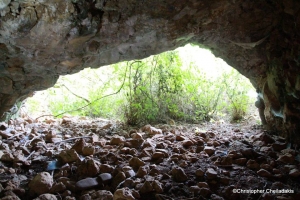Many places in Crete still host military refuges dating back from the Second World War. The shelters are small or large, with deep complex corridors were all created by Cretans to protect ammunition and other materials of the Germans and protect areas by aerial bombardments and mounting guns. Shelters are found literally everywhere, which shows how important Crete was for the outcome of the war.

One of the very easily and really small shelters that are open to people is located in the city of Chania. It is located just behind the church of St. Spyridon and has two entrances like most. The shelter of Saint Spyridon is only a few meters deep. No light is needed as the gallery is quite short. The shelter was built at the site of a former cave, the entrance of which is blocked by boulders.

Malaxa village is the entrance to the region of Keramia by Chaniaa and is built on a very strategic point. It is the only passage to the mainland and it is built atop Mount Verekynthos, having views to the region of Chania and Souda Bay. Therefore, the Germans during the Second World War built many shelters, only the village hosts three.

Crete is a place with endless diverse beauties that it has always new places to show, even to those who think that know Crete well. Some of these treasures are hidden below the surface. One of these places is a German shelter several meters below the surface of the earth that has never until now been recorded in photos. This shelter, so many years after the liberation of Crete in 1945, keeps it secrets well hidden. The area has loose grounds and the entrance to it is really dangerous. All its main gates have been blocked by colissions, making it impossible to enter. Entering the shelter can be made from another place using a rope.

A living museum of historical memory that is worth seeing by any visitor of Crete that records the suffering of the Greek people during the German Occupation, is the galleries of Platanias. The shelter was built below the church of Agios Dimitrios at Pano Platanias by the requisitioned locals, for the Germans.

The wider region of the village Alikambos, at Chania, we meet several caves because of the limestone bedrock. One of these caves is Fourni located in the village. Fourni unlike other caves of the region does not bear cave decoration as it is really poor. However it surely has the most important history of all, because it is located inside the village and, therefore, served as a shelter for the locals, especially during the bombardments of the Second World War. Fourni entrance is not easy to access, due to being blocked by rubbish and vegetation.












































































